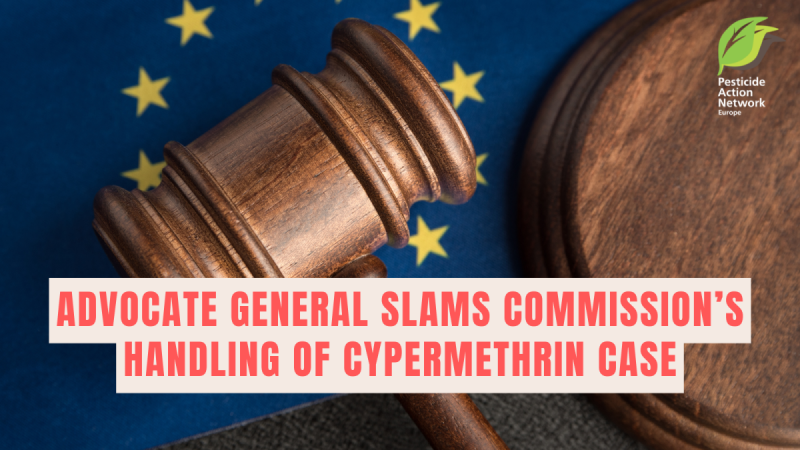The Advocate General of the EU Court of Justice has issued a powerful legal opinion in our ongoing dispute over the European Commission’s 2021 decision to re-approve cypermethrin, a highly toxic insecticide [1]. Opposing the Commission and the General Court, the Advocate General recommends annulling the earlier court judgment that upheld the approval. She raises serious questions about how the Commission assessed the risks. While not legally binding, this opinion is influential. So, what exactly did the Advocate General say?
The Advocate General identified four major failures in the Commission risk management that led to the re-approval of cypermethrin. Each of these reflects a failure to meet the legal requirement for a careful, impartial, and science-based assessment.
1. Toxicity of the isomers
Cypermethrin is a mixture of isomers, molecules with the same formula but different structures. EFSA had flagged a critical data gap regarding the toxicity of the isomers. Indeed, mandatory data was not provided by the industry. The Commission allowed this gap to remain unaddressed at the time of re-approval, treating it as "confirmatory information" that could be submitted later. The Advocate General firmly rejected this approach. Basic toxicological data must be complete before approval. Confirmatory data may only be used to refine, not fill, major data gaps. The Commission’s failure to require this data up front violated the law.
2. Long-term toxicity of the actual product
The Commission did not ensure that the potential long-term toxicity and carcinogenicity of a representative formulation had been assessed. Such assessment is mandatory under EU law, but the European Commission always refused to include the needed data in the so-called 'data requirements regulation'. In the absence of such data, the European Food Safety Authority (EFSA) did not perform this assessment. And when asked to explain why that was acceptable, the Commission pointed to a confidential section of the renewal report by the Rapporteur Member State. The Advocate General was not convinced. If this “hidden” data were truly sufficient, the Commission and the General Court, should have examined it openly and justified why EFSA’s silence on the issue could be ignored.
3. Risk mitigation measures
EFSA had concluded that even with risk mitigation measures, cypermethrin posed a high risk to non-target organisms. Nevertheless, the Commission claimed that extreme mitigation measures, such as a 95% reduction in pesticide drift, would solve the problem. EFSA had already stated such measures were not realistically feasible. The Advocate General found no scientific justification for the Commission’s decision to override EFSA’s conclusion.
4. Genotoxic potential of impurities
Another central concern raised by EFSA about cypermethrin is the impossibility of ruling out the genotoxic potential of impurities of the technical specification. The Commission relied on the Rapporteur Member State’s claim that this formulation was “equivalent” to that in the toxicity studies, but the Advocate General found this deeply unconvincing without knowing exactly what the differences were between the specifications.
Throughout her opinion, the Advocate General stresses a simple principle: when the Commission overrides EFSA’s scientific opinion, it must justify it. If EFSA says there’s a risk, the Commission cannot just say, “We disagree.” It must explain why, based on science and facts. Crucially, the Commission relied heavily on input from one Member State (the Rapporteur, Belgium), even when that view conflicted with EFSA. The Advocate General found this unjustified and legally flawed.
The Advocate General also criticises that the Commission withheld key information about the formulation assessment, claiming it was confidential. The Advocate General recalls that data concerning emissions into the environment must be made public. That is a core part of both EU law and the Aarhus Regulation.
Not all arguments from PAN Europe were upheld by the Advocate General. For instance, she considered there was no demonstration that the endocrine-disrupting properties of cypermethrin could be expressly established based on the required data.
Several of these key arguments could be a game changer in the future of pesticide decision-making, as these represent regular issues with the way the European Commission manages pesticide approvals.
What happens now?
A final ruling by the Court of Justice is expected in late 2025. If it follows the Advocate General’s recommendation, the judgment of the General Court will be annulled. The Commission would have to review the reply they gave to our Request for Internal Review, and most probably review the approval of cypermethrin.
Read our press release.
Background:
Cypermethrin is a synthetic pyrethroid insecticide highly toxic to bees and aquatic organisms, and suspected to disrupt the human endocrine system. Despite clear warning signs (‘critical areas of concern’) and an incomplete dossier, the European Commission and Member States reapproved the substance in 2021. PAN Europe launched a legal challenge, arguing that the Commission ignored EU law, EFSA’s scientific assessment, and the precautionary principle. In 2024, the General Court of the EU dismissed the case against the re-approval of cypermethrin [2], and PAN Europe appealed that decision in front of the Court of Justice [3][4]. In today's opinion, the Advocate General recommended the Court of Justice to annul the judgment of the General Court.
Notes:
[1] Opinion of the Advocate General of the EU Court of Justice
